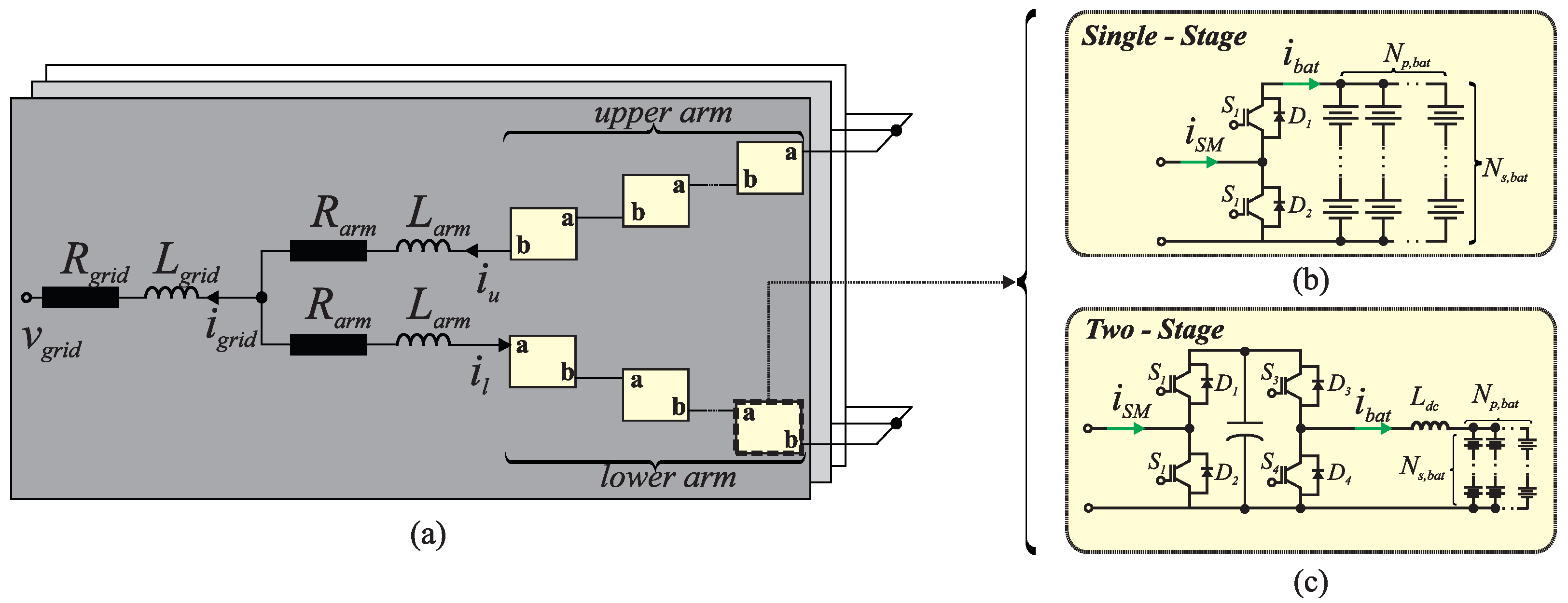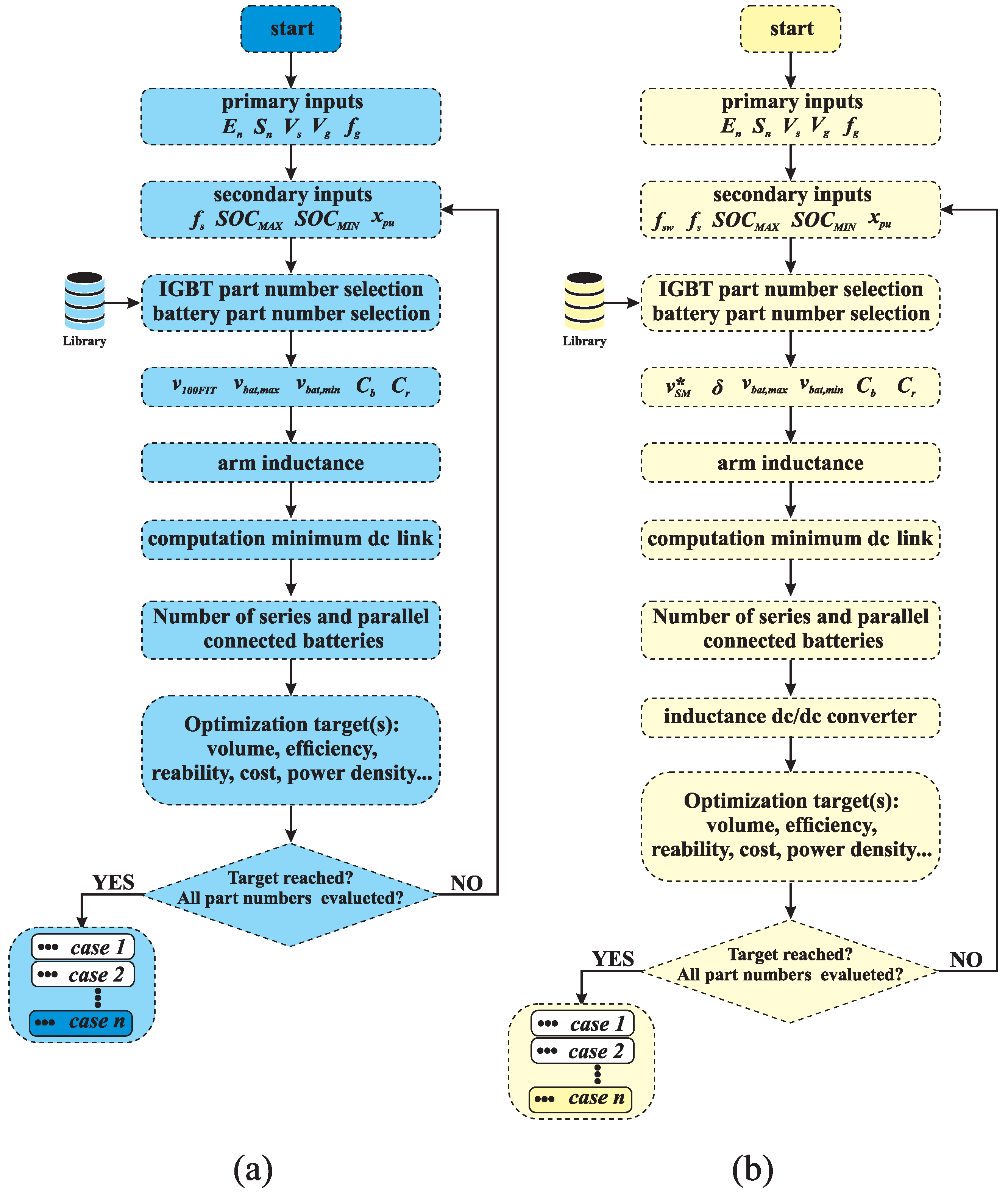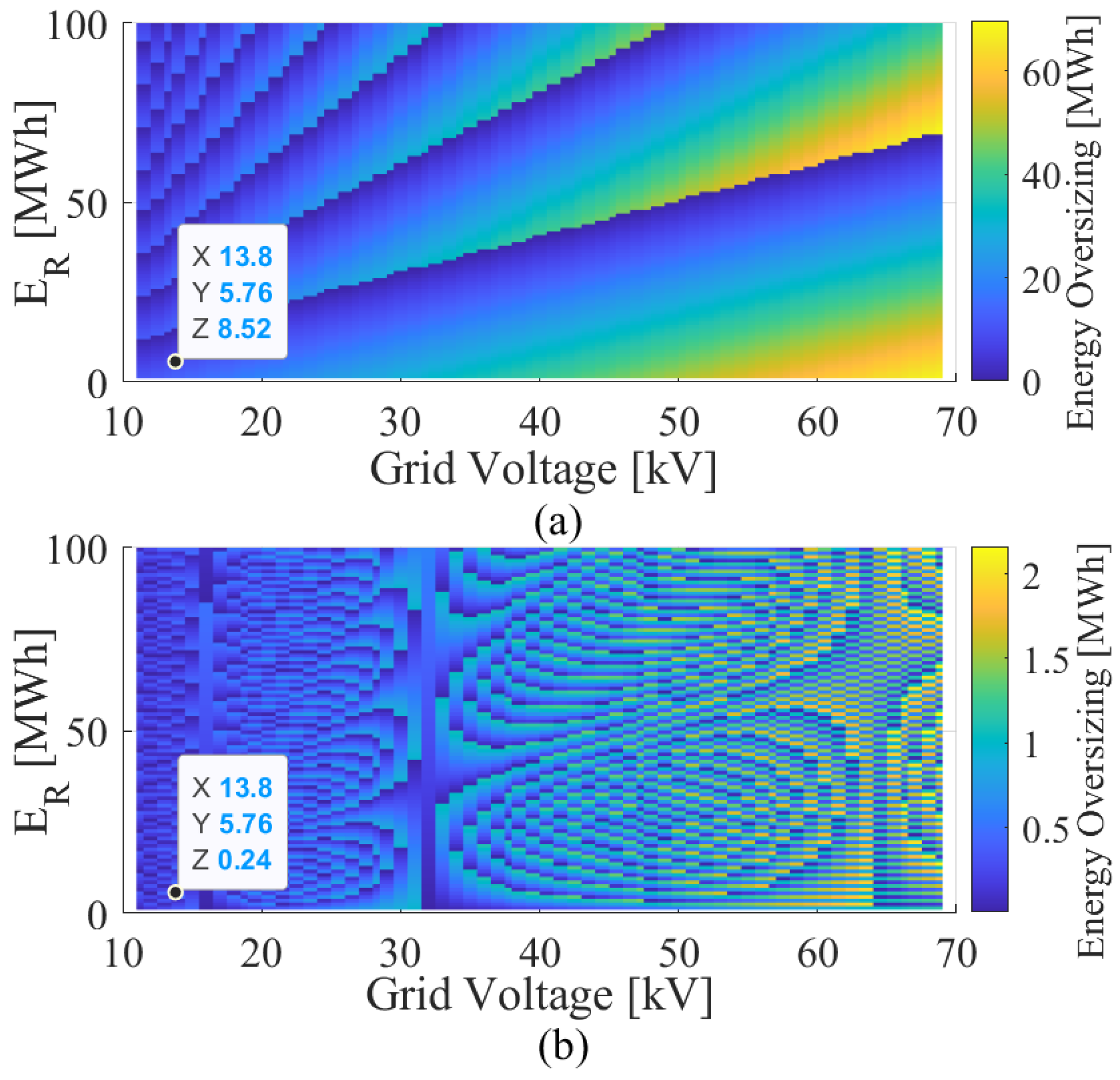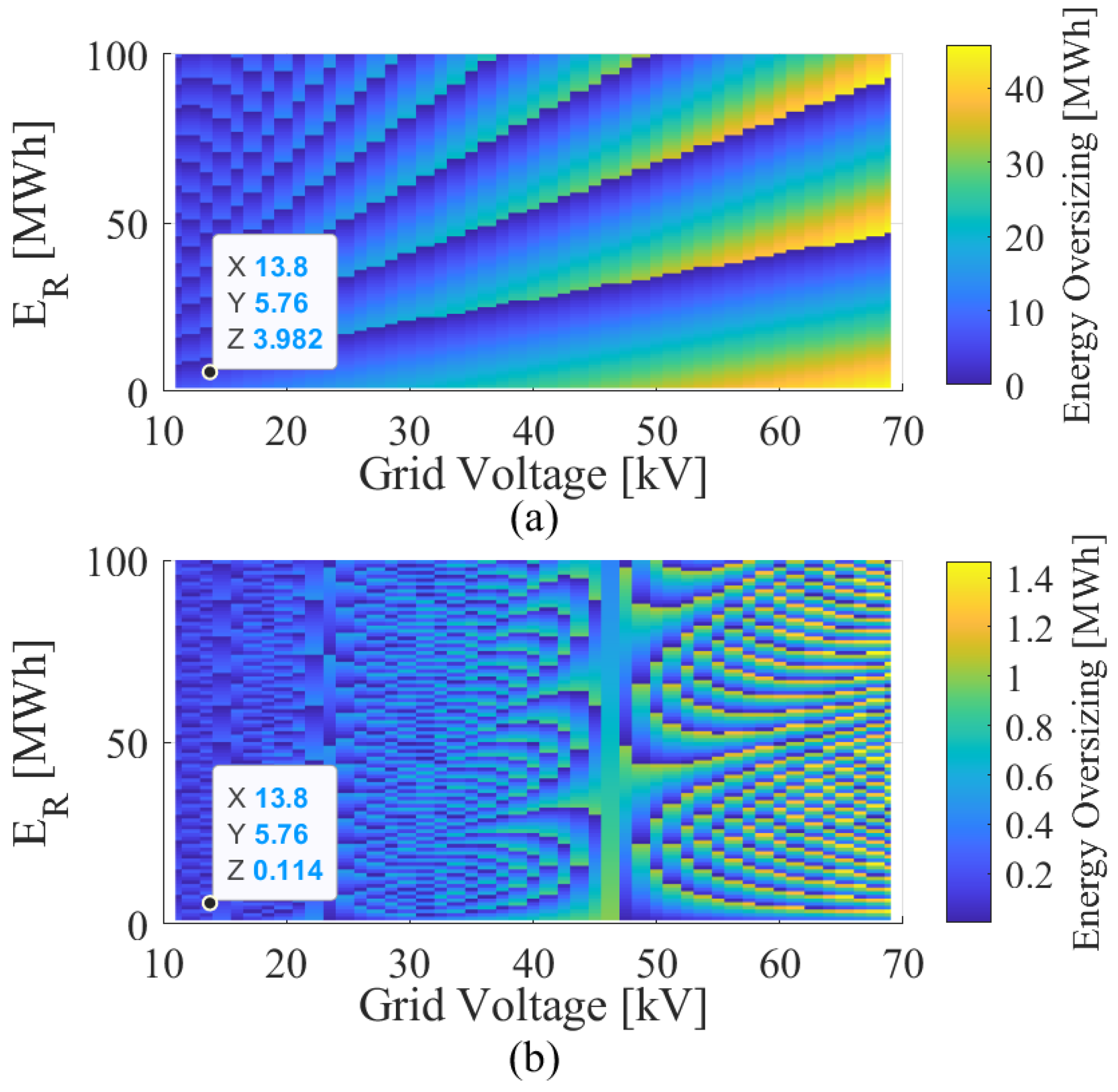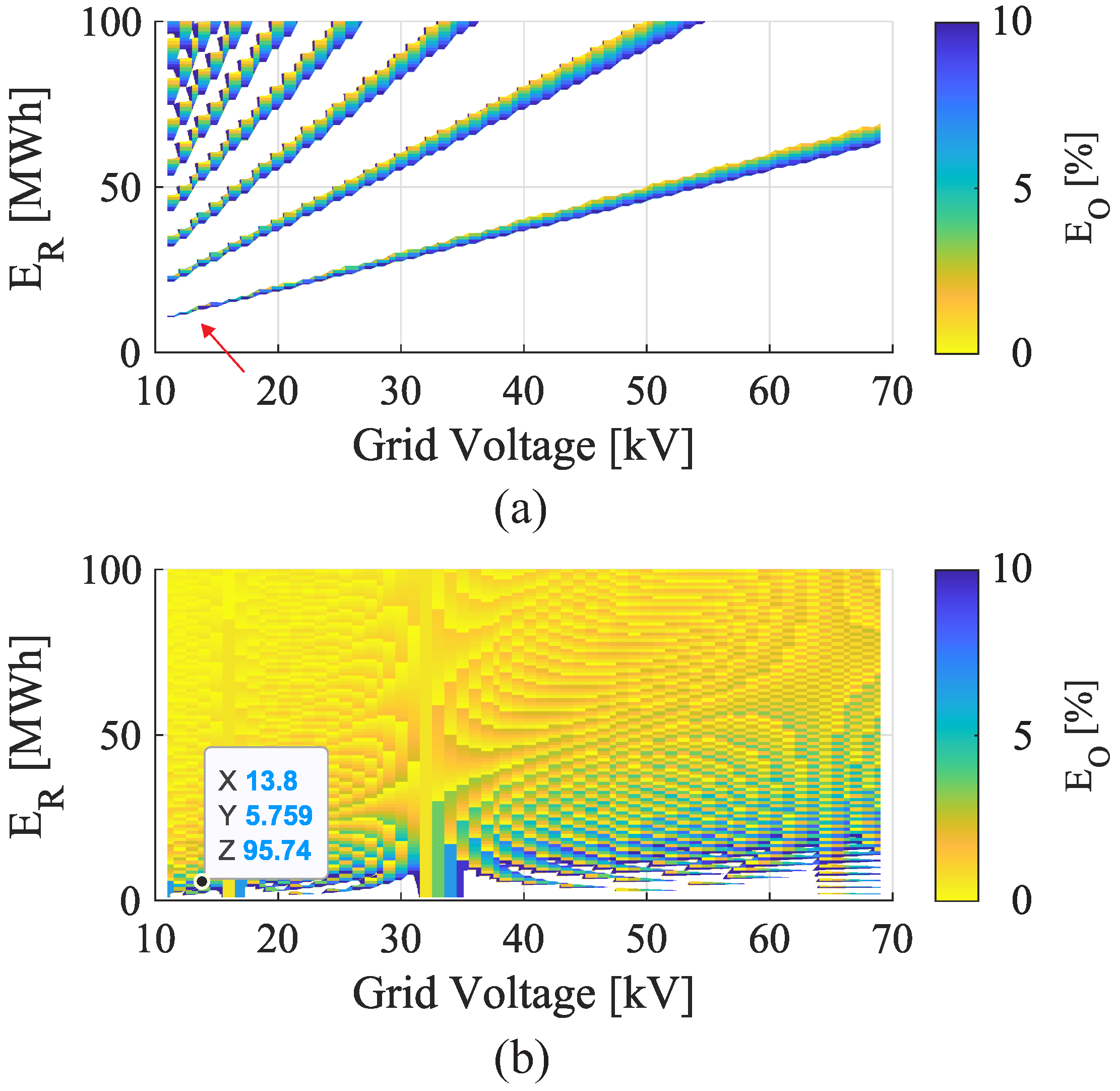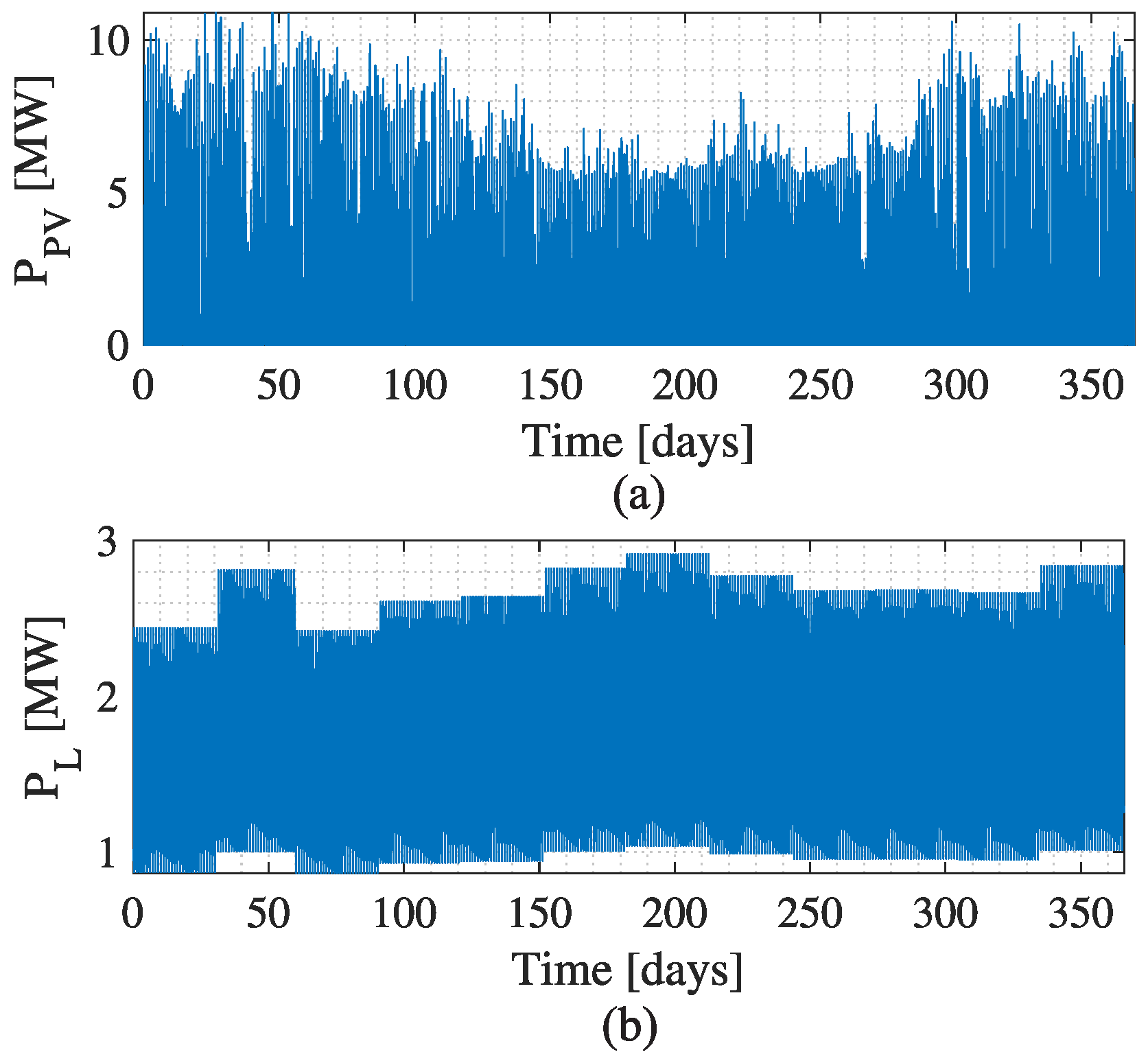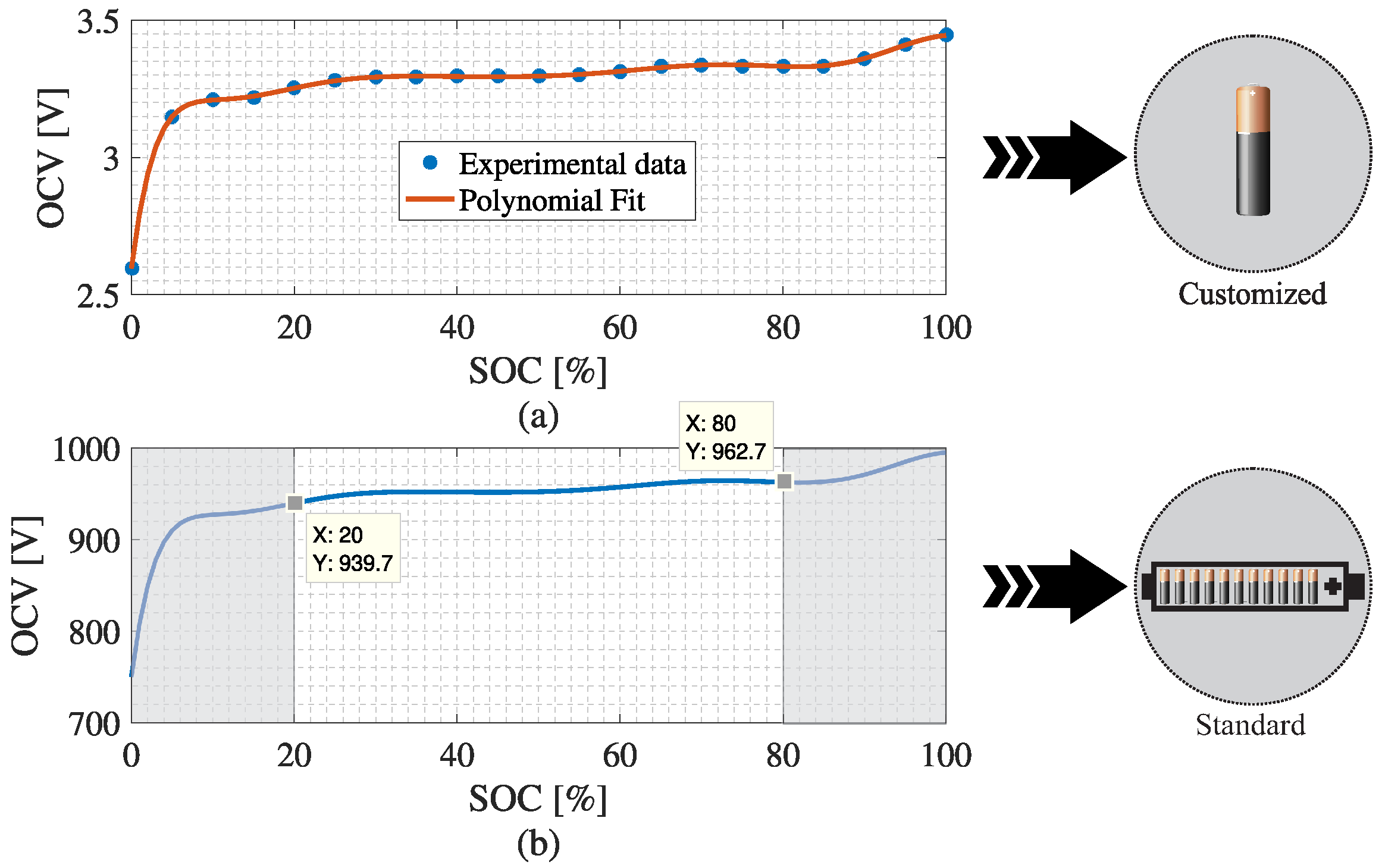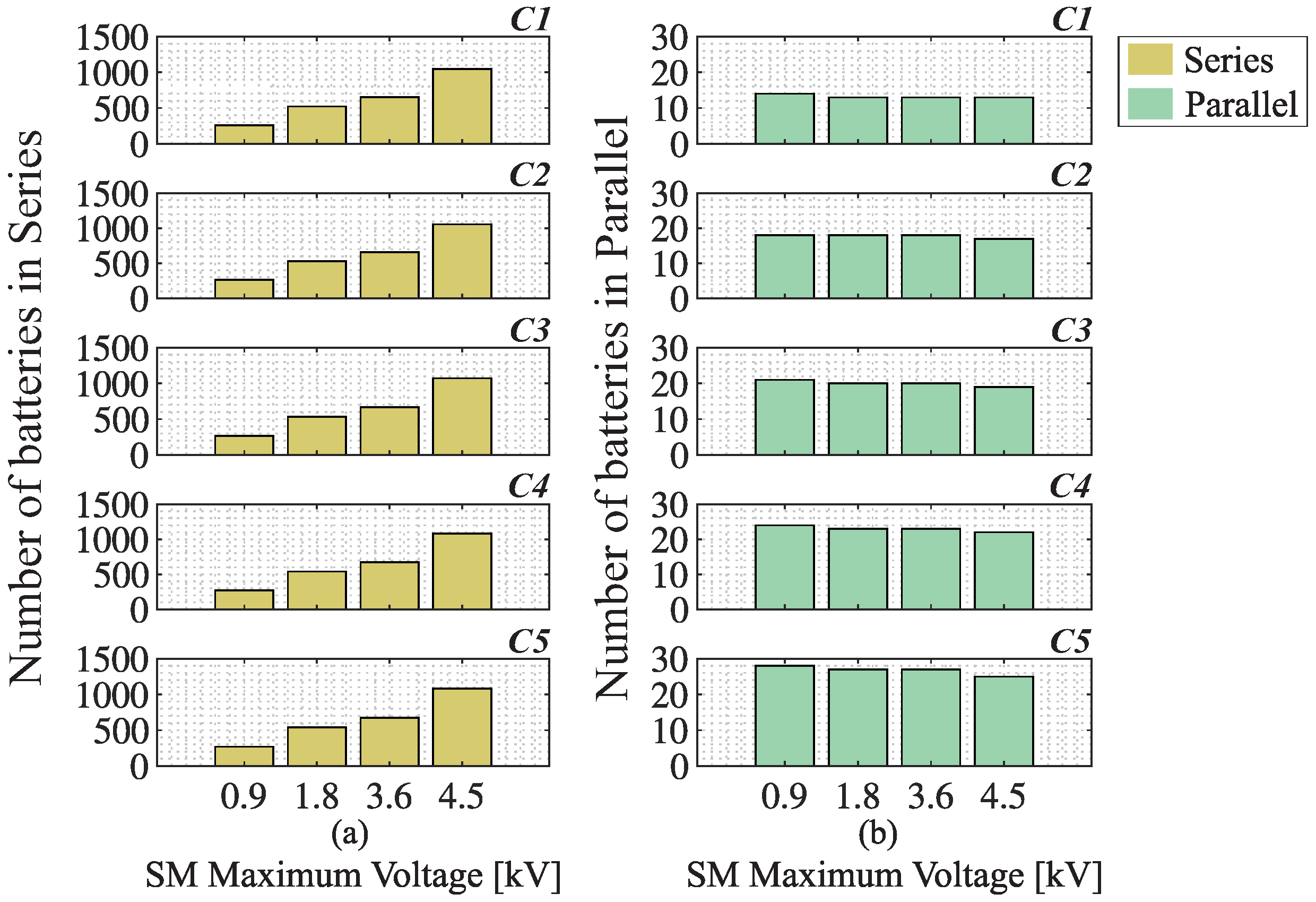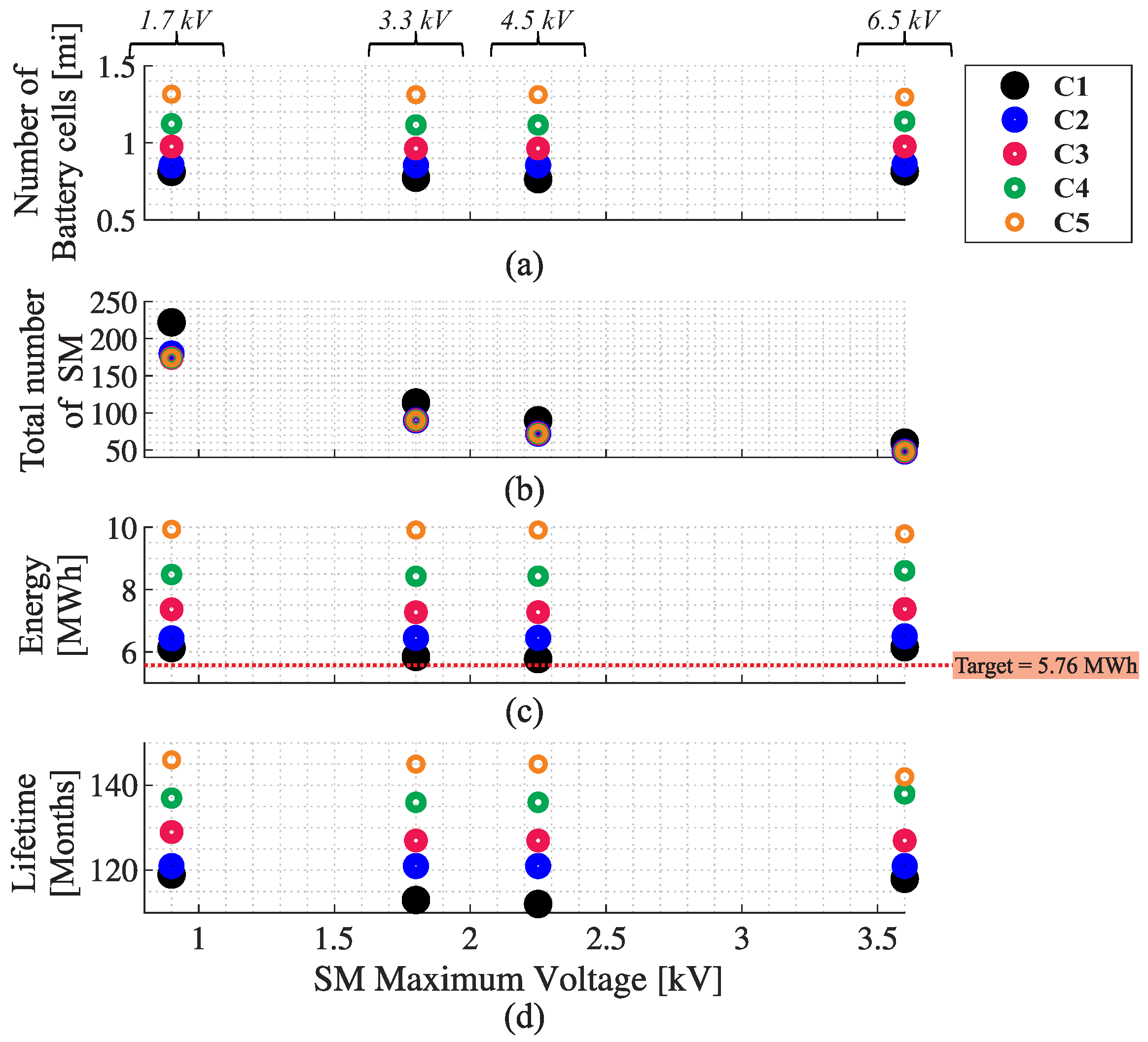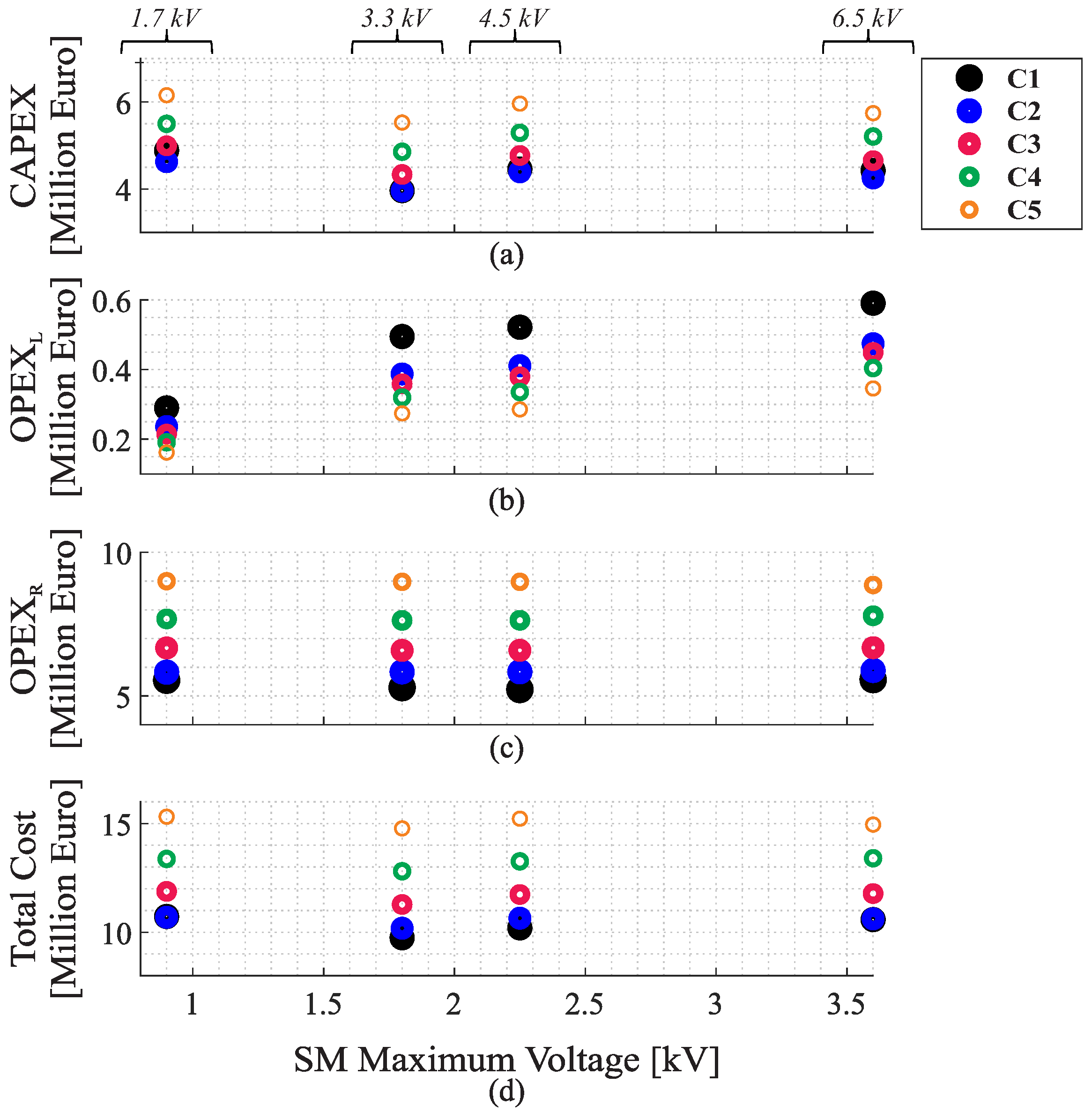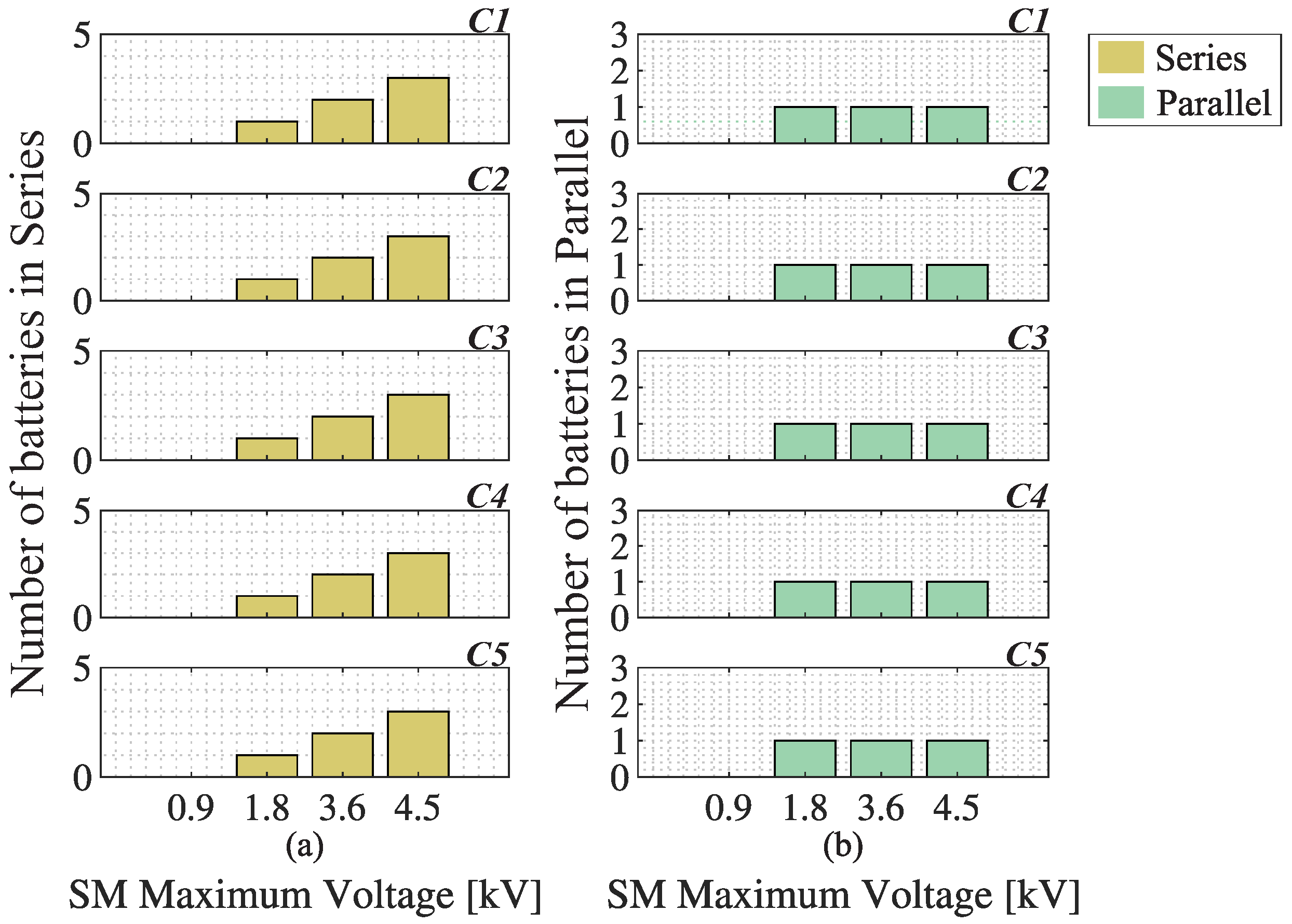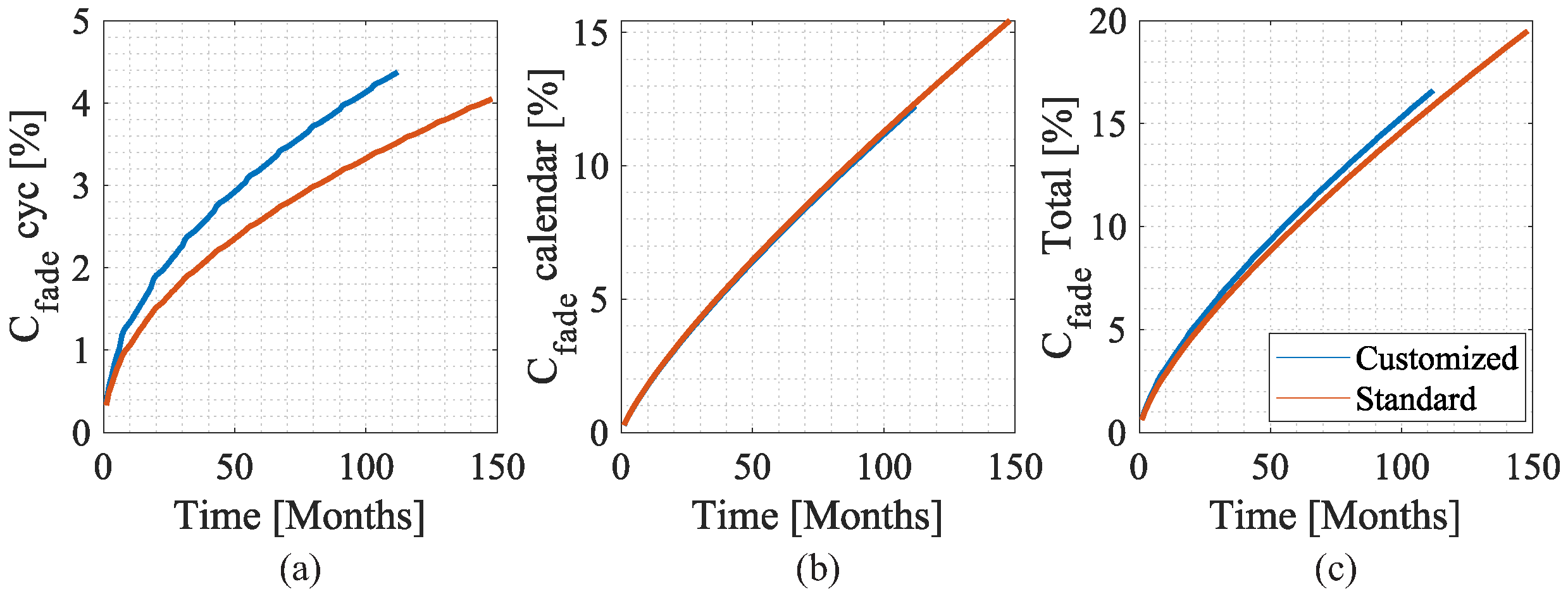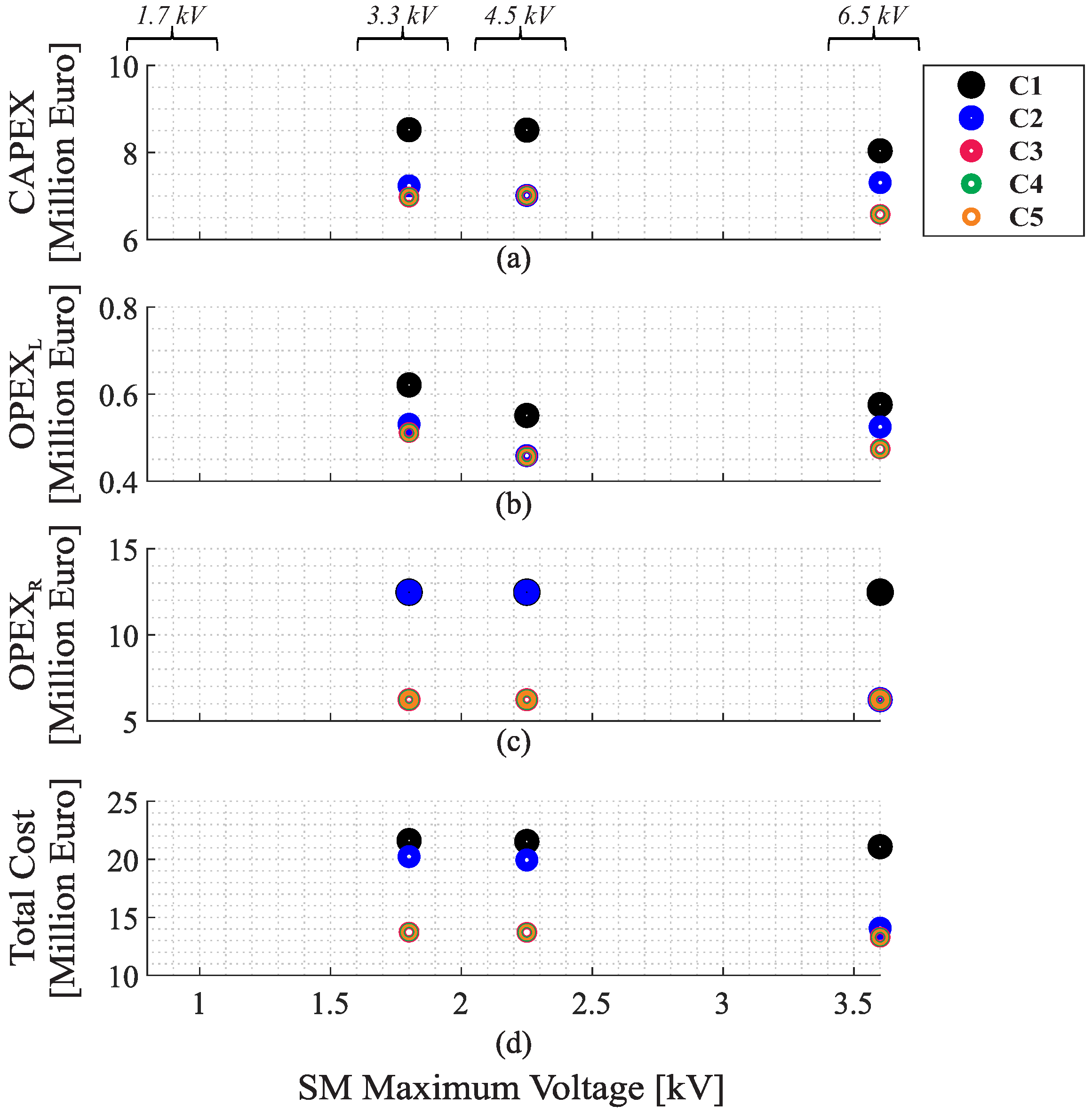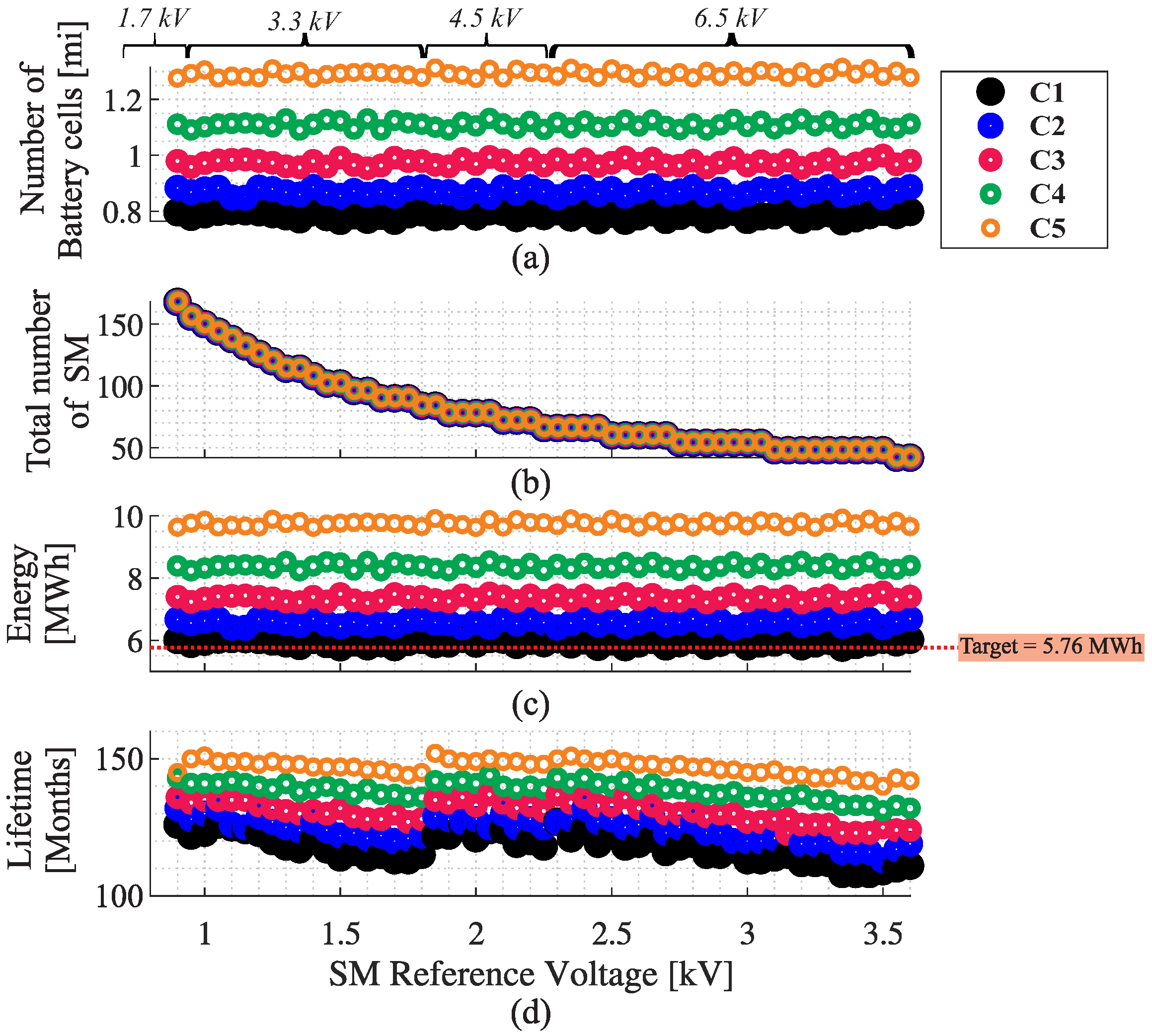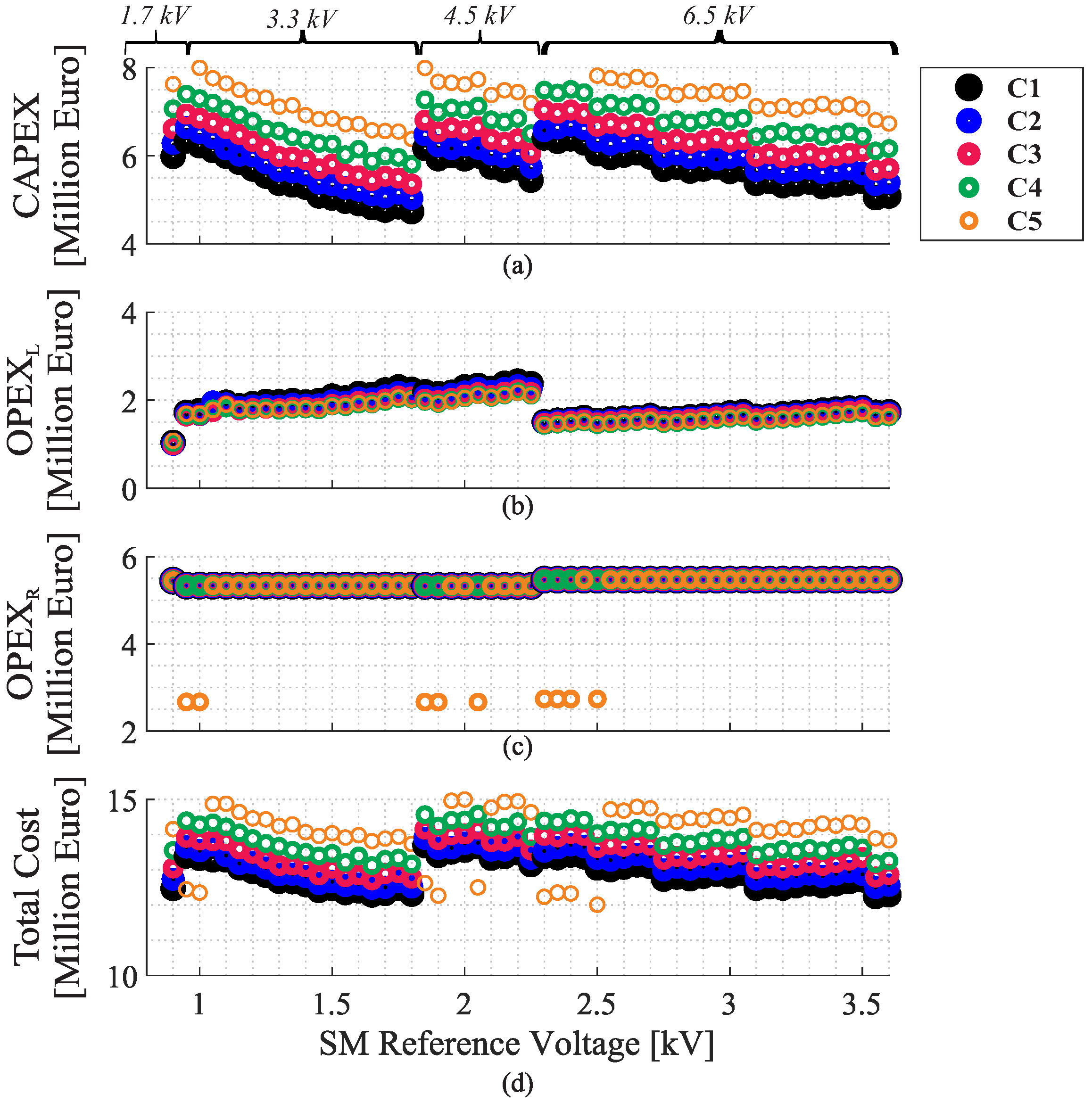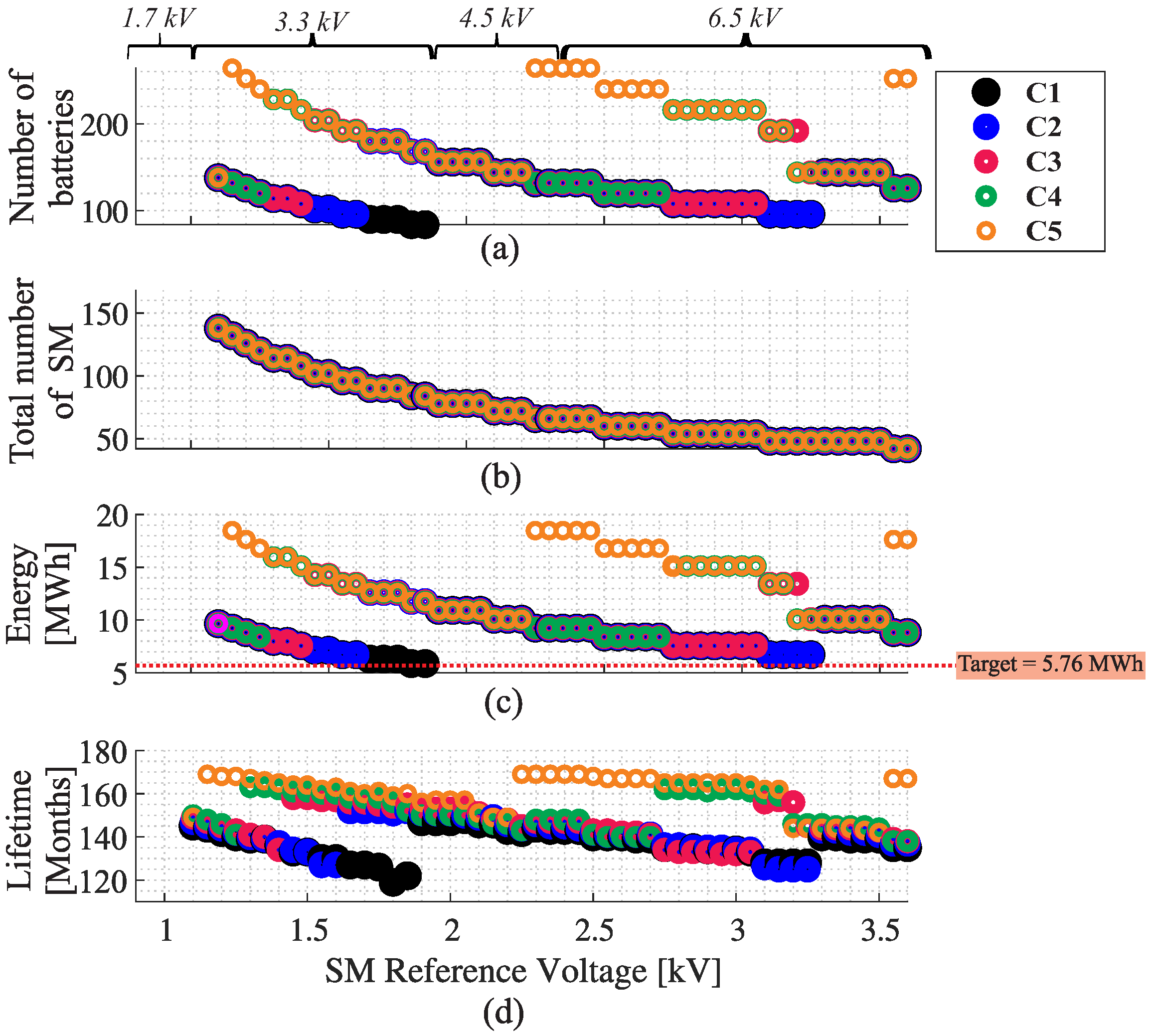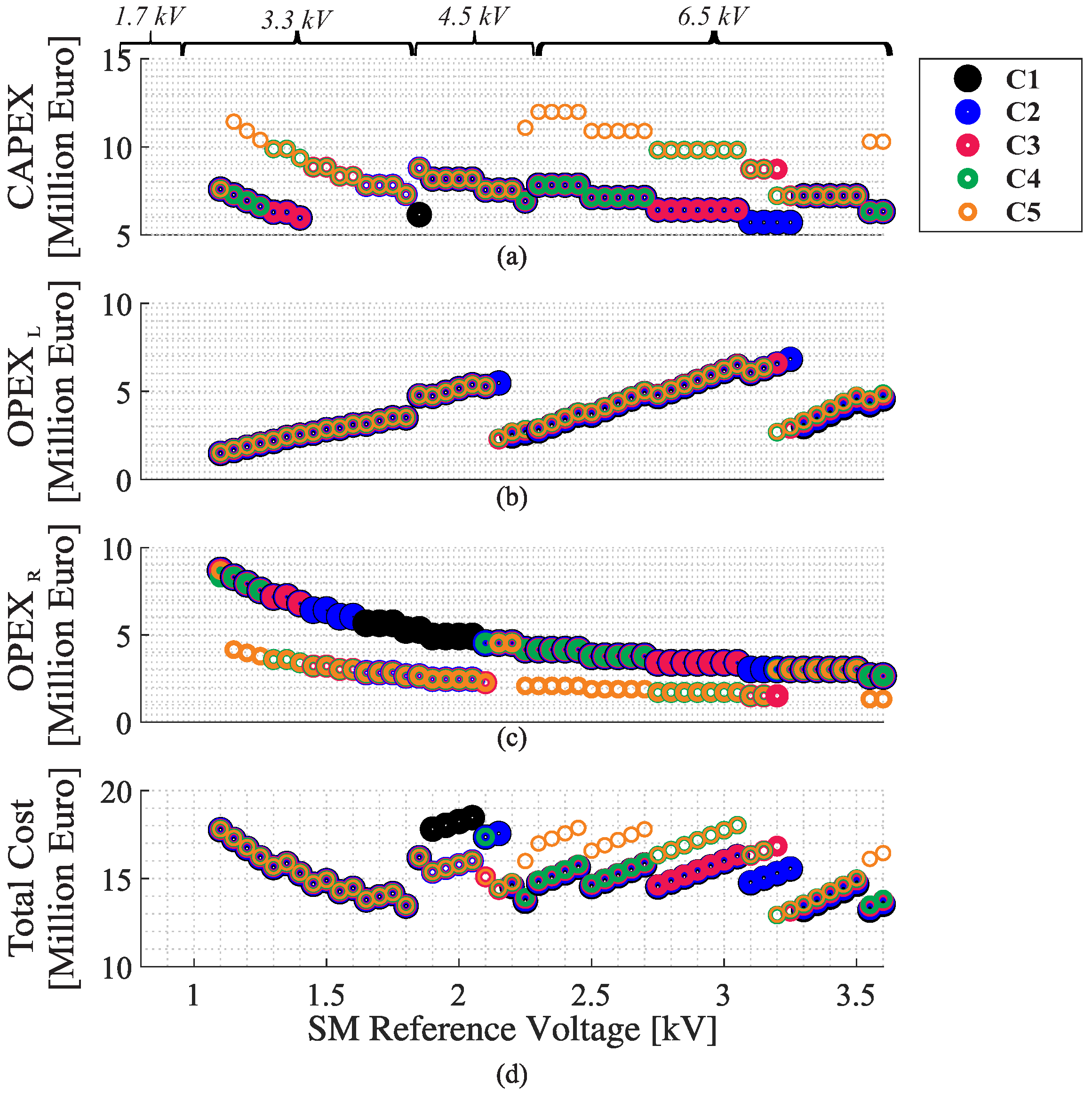1. Introduction
In recent decades, economic and population growth have contributed to increased demand for electricity in the world [
1]. Renewable energy sources (RES) such as photovoltaic systems (PV) and wind farms (WPP) have emerged as alternatives to supply this energy demand.
One of the main concerns regarding RES is intermittency, which is an inherent characteristic. Battery energy storage systems (BESS) have grown considerably. The use of a BESS presents benefits such as flexibility in the location for installation, shorter construction time of the facilities, and quick response time to system events [
2]. This technology has been used to provide several ancillary services, such as time-shift and peak shaving, among other services.
The connection of the BESS to the grid is carried out through power electronics [
3]. References [
4,
5] indicate the modular multilevel converter (MMC) is an option to perform BESS integration with the grid. The MMC is composed of dozens or hundreds of submodules (SM) connected in cascade in each converter arm [
6]. This topology shown in
Figure 1a presents some advantages such as a high voltage level, a low switching frequency, fault tolerance, redundancy, modularity and design flexibility [
7].
The association of a BESS with MMC is denominated as an MMC-based BESS. In this system, the battery rack can be connected directly to the MMC dc-link, called a centralized configuration, or disposed in each SM of the MMC, called a distributed configuration [
8]. In a centralized configuration, long strings of batteries are needed to obtain high voltage [
9]. According to
Figure 1b,c, two configurations of an MMC-based BESS are investigated in this work: single-stage (SS) and two-stage (TS). In the SS approach, the batteries are connected to the SM. This connection can be direct [
10] or through passive filters [
10,
11]. The battery current presents low-order harmonic components. These components, especially the first-order and second-order, increase the battery RMS current. References [
10,
12] state that low-order harmonics can increase the internal temperature of batteries. Therefore, it would increase the internal losses of the battery, which could reduce battery life. An alternative to mitigate the low-order harmonic contents is the use of passive filters [
11]. However, the use of these filters can increase the volume of SM, especially associated with inductors [
13].
In the TS approach, the batteries are decoupled from the SM through a dc/dc converter [
11,
14]. The current in the batteries presents a considerable reduction in low-order harmonics. In this case, the SM volume is reduced. References [
11,
14] claim that this approach is interesting from a battery life point of view. Furthermore, the voltage of Li-ion batteries can vary by up to 30% from a fully discharged to a fully charged state [
15]. In the TS approach, the dc/dc converter varies the duty cycle to keep the SM voltage constant. Consequently, the number of batteries and SMs can be reduced.
Reference [
16] presents MMC settings to associate with a BESS. Among the configurations, those that offer the potential for greater efficiency and reliability are presented. Reference [
15] presents the integration of an MMC with a BESS through the dc/dc converter in each SM. However, the literature does not present a comparison between SS and TS approaches considering metrics such as cost, efficiency, volume, and lifetime. Furthermore, evaluating the performance of topologies is necessary.
The roundings functions used in BESS sizing impact the energy oversizing of the project. Thus, this work evaluates projects with commercial battery racks (standard solution) and projects with customized battery racks (customized solution). In the customized solution, small battery cells are used to form the battery rack. In this sense, a figure of merit varying the grid voltage, required energy and energy oversizing is perfomed.
The adopted case study compares SS and TS approaches for standard and customized solutions. The case study is carried out for 10.9 MVA/5.76 MWh–13.8 kV for an MMC-based BESS. This system aims to perform time-shift in an industrial plant. In the analysis, different IGBT models and different SOC ranges are compared.
The metric used to compare the SS and TS approaches is the total project cost. The total costs can be divided into two terms: capital expenditure (
CAPEX) and operational expenditure (
OPEX) [
17]. In addition, an analysis of the battery lifetime is carried out. The replacement of batteries is analyzed considering an operating period of 25 years.
This paper is organized as follows:
Section 2 presents a methodology for BESS sizing in SS and TS approaches. In
Section 3, an analysis of the battery current for SS and TS approaches is performed.
Section 4 analyzes the effects of rounding on BESS sizing in both customized and standard solutions.
Section 5 presents the case studies and methodologies to calculate the costs related to each design of the single-stage and two-stage approaches. Afterward, the results for the SS and TS approaches in the customized and standard solutions are presented in
Section 6. A discussion of the results obtained is in
Section 7. Finally, the conclusions about the work are presented in
Section 8.
2. MMC-Based BESS Design
The flowcharts to optimize the BESS designs in SS and TS approaches are presented in
Figure 2a,b, respectively.
The first input parameters are the MMC-based BESS specifications such as nominal energy storage (
), nominal power (
), grid voltage (
), and grid frequency (
). Furthermore, in the first step in the converter design, the minimum required output voltage that guarantees the connection to the grid is calculated. This value is computed by [
8]:
where
is the maximum value of the line-to-neutral voltage,
is the maximum variation, in pu, verified in the grid voltage, and
is the converter output reactance, in pu. The margin of 5% is assumed to guarantee a suitable dynamic behavior in the current control [
11,
18].
The next input parameters are variables that can be changed for optimization purposes. For both approaches, the following are considered: switching frequency (), SOC interval ( and ), and per unit equivalent output reactance of the converter (). Furthermore, in the TS approach, the switching frequency of the dc/dc converter is considered (). In this step, the adjustment of the parameters has an influence on the optimization of the system. For example, the SOC operating range affects the volume and efficiency of the MMC and the lifetime batteries.
The MMC must be able to synthesize
in the limit region of the modulator. The sum of the capacitor voltages (
) is obtained from
. This relationship depends on the topology and the modulation strategy used. In this way, the sum of the capacitor voltages of each arm when using the SPWM is 2
. Another interesting approach that makes it possible to extend the linear region of the modulator is to consider
third harmonic injection [
19]. Thus, the sum of the capacitors is
.
In the SS approach, the number of series batteries in each string,
, can be calculated according to:
where
is the maximum battery voltage, and
is the SM maximum voltage (equivalent of blocking voltage of IGBT,
). The 100-FIT voltage leads to a FIT rate of one failure in
h of operation. This value is used in projects of reliable converters [
20]. The function
floor is used in Equation (
2) to ensure that the maximum voltage of the batteries exceeds the
. The total number of SM is computed by:
where
is the minimum battery rack voltage, limited by the
SOC. The number of batteries in parallel must fulfill two requirements: power and energy. Therefore, the number of batteries connected in parallel can be calculated as follows:
where
is the MMC nominal power,
is the rate of battery discharging,
is the battery nominal capacity,
is the requirement of nominal energy storage in the converter,
is the battery rack nominal energy,
SOC is the maximum allowed
SOC, and
SOC is the minimum allowed
SOC. Note that in Equation (
4), the calculation
SOC −
SOC is considered an approximation of the value of battery power. This approximation applies because the OCV ×
SOC curve presents a linear behavior at the beginning and at the end.
In the TS approach, the dc/dc is a boost converter. Thus, the total voltage of the battery rack varies according to the duty cycle. Since the dc/dc converter decouples the batteries from the SM, the number of batteries in a series by string is represented by:
where
is the SM reference voltage, and
is the gain used to guarantee that the dc/dc converter controller does not saturate. As the converter used is of the boost type, the condition
must be met;
must be higher than the battery voltage and lower than the power module’s maximum voltage (recommended by the manufacturer). Finally,
for the TS approach is determined as follows:
As presented in [
15], in the TS approach,
is a variable to be analyzed in the converter optimization process. Finally, Equation (
4) can be used to determine the number of batteries in parallel for the TS approach.
Passive Components
The capacitance SM is defined based on the power requirement of the converter. According to [
19], it can be calculated as follows:
where
is the requirements of the energy storage in the converter, given in kJ/MVA, and
is the converter nominal power. According to [
7,
21], considering 10% ripple criterion of SM voltage, W = 40 kJ/MVA is the typical adopted for the MMC.
The arm inductance of the MMC is computed by:
where
is the value of arm reactance, in pu, and
is the grid angular frequency. According to [
22], typical arm inductance values can vary in the range of 0.05 to 0.15 pu. In this work, 0.15 is adopted.
The maximum value of the arm current value is adopted to determine the semiconductors devices and inductors [
7]. As previously discussed, at balanced conditions, the circulating current can be neglected. In this way, the maximum arm current is calculated as follows:
Finally, for the TS approach, the minimum value of inductance to guarantee that the dc/dc converter operates in continuous conduction mode can be expressed by:
where
is the switching frequency of the dc/dc converter, and
is the maximum battery current ripple.
3. MMC Mathematical Model
According to [
22], the upper arm current of
phase-n, (
) and the lower arm current of
phase-n, (
) can be written as follows:
where
is the grid current of
phase-n, and
is the circulating current of
phase-n.
The upper arm voltage of
phase-n (
) and the lower arm voltage of
phase-n (
) can be expressed by:
where
is the
i-th SM voltage, and
and
are the insertion index for the upper and lower arms, respectively.
Regardless of whether the system is a SS or TS approach, the variation in arm power will generate a ripple current in the battery. In addition, if the system is balanced,
. Therefore, the instantaneous active power in the upper arm is given by:
where the injection of 1/6 of a third harmonic in the modulation strategy is assumed [
19], and
is the amplitude of the line-to-neutral output voltage.
Assuming negligible power losses and that the converter power is evenly distributed to the SM, the SM current can be approximated by:
Therefore,
can be expressed as follows:
where
is the amplitude of the grid current, and
m is the modulation index, given by:
According to Equation (
15),
has significant first, second, and fourth harmonic components which can generate a ripple current in the battery. In the SS approach, once
=
, if no filter is applied in the SM, the fundamental, second, and fourth harmonic components flow in the battery.
In the TS approach, the lower order harmonic components are strongly attenuated. Compared with the SS approach, the fundamental and second-order harmonics have been reduced considerably. On the other hand, in the TS approach, harmonic components are derived from the switching of the dc/dc converter. The battery current () in the SS approach without passive filters is equivalent to . On the other hand, in the TS approach, is equivalent to the dc component (in an operating condition of perfect filtering of the components ac).
Therefore, the effective current in the battery in the SS approach (
) and in the TS approach (
) can be calculated as follows, respectively:
where
is the duty cycle. Furthermore,
.
The harmonics increase the RMS value of the current and consequently of the temperature. Consequently, it increases battery losses and reduces battery life [
23,
24]. Therefore, the temperature variation in the batteries in the SS approach (
) and in the TS approach (
) can be calculated as follows:
where
and
are the battery equivalent to internal resistance and battery thermal resistance. In addition,
and
are the number of batteries in parallel for single and TS approaches.
To compare the temperature variation in the SS and TS approaches, we considered the power for both systems andthe full-rated power in the SM for both. Therefore, in the TS approach, the duty cycle () varies the current so that both process the same power. Consequently, .
Finally, the relationship between
and
can be obtained as follows:
It is important to note that this temperature variation is increased by the ambient temperature of the batteries. Furthermore, this relationship is only valid if the same power synthesized by the SM in both approaches is considered.
Some variables can influence this relationship to be changed such as rounding in dimensions, different designs, and the type of service provided by the battery. For systems where the battery current is low, the battery cycles little or does not run for some interval and the temperature variation is low. Therefore, this variation may not significantly affect battery degradation.
4. Effects of Rounding Functions on BESS Design
As discussed in
Section 3, due to the use of
floor and
ceiling rounding functions in the BESS sizing, the required nominal energy storage capability and the actual energy storage capability can differ significantly. This difference can be measured through the energy oversizing given by:
where
is the total energy of the batteries, and
is the energy required by the system. The magnitude of
is a function of the design ratings and the battery rack characteristics. This work investigates standard and customized solutions.
A standard solution is sized with commercially available battery racks. These battery racks have high values of voltage, energy storage, and Ah-capacity. On the other hand, the customized solution uses a battery cell with lower voltages, energy, and capacity to carry out the project.
One cell and one rack battery were selected to exemplify the consequences of rounding in the sizing for the SS and TS approaches. For the standard case study, a battery rack was chosen, and for the customized alternative, a battery cell was adopted.
Table 1 presents the parameters of the battery rack and the battery cell needed to carry out this study.
According to the parameters defined for the batteries, BESS sizing was carried out considering different values of grid voltage (11 kV to 69 kV) and energy requirements (1 MWh to 100 MWh). To exemplify the behavior of the system, IGBT-blocking voltage 4.5 kV was used for the SS and TS approaches. Furthermore, the dc-link voltage used for the tests was 2.25 kV. Note that these values are just for example, they are not necessarily the best configuration options for the SS and TS approaches.
Figure 3 presents an analysis of energy oversizing for different voltage and energy required values. In
Figure 3a, the values for the standard solution are shown. Note that projects with less energy oversizing are shown diagonally in the darkest color. For the selected case study, the energy oversizing approaches 50%. On the other hand, in the customized solution shown in
Figure 3b, the range of energy oversizing in the standard solution is up to 30 times higher than in the customized solution. Furthermore, more areas have less energy oversizing.
Figure 4a,b analyze the energy oversizing for the TS approach in the customized and standard solution, respectively. In the TS approach, the dc/dc converter adds a degree of freedom which makes the magnitude of energy oversizing decrease compared to the SS approach. In addition, in
Figure 4b, there are more regions with less energy oversizing. Finally, the highlighted points in
Figure 3 and
Figure 4 refer to the case study that will be discussed in the next sections. Note that the chosen parameters
and mains voltage do not lead to designs optimized for the standard solution.
After evaluating energy oversizing for different types of projects with grid voltage and energy required, the next figures aim to select the best projects.
Figure 5 selects the projects from
Figure 3 that have a maximum of 10% energy oversizing. In the standard solution shown in
Figure 5a, note that the point selected in
Figure 3a is not within the applied limit. As for the customized solution shown in
Figure 5b, it shows that the point selected in
Figure 3b is within the stipulated 10% limit.
Figure 6a presents the projects selected for the TS approach in the standard solution. Note that the project selected in
Figure 4 is not contained within the established limit. Considering the TS approach customized solution presented in
Figure 6b, the projects contemplate the energy oversizing closer to 0%. However, in the same way as in
Figure 5b, for low values of required energy, few projects are selected.
As noted, battery behavior and characteristics are important for design analysis. In addition, the TS approach offers more flexibility, reducing the oversizing factor for some solutions. It is worth mentioning that another degree of freedom is the voltage change SM in a TS approach, as discussed in [
15].
5. Case Study
Figure 7a shows the PV power plant generation for the city of Viçosa in the state of Minas Gerais, Brazil, based on a 10 MW PV system. In addition,
Figure 7b presents the active power profile over one year for a typical load at the Federal University of Viçosa.
The association of an MMC-based BESS with a grid and the load consists of generating and storing energy at the lowest tariff time (off-peak hours) and using it at the highest tariff interval (peak hours). In order not to charge demand at peak hours, the load has to be supplied throughout the entire collection time interval. This period of time and days analyzed varies by location and utility. In this work, an interval of 3 h was considered, from 5 p.m. to 8 p.m. (except on weekends).
The parameters adopted to carry out the study of the MMC-based BESS are presented in
Table 2.
Based on experimental results for a single LiFePO
battery from [
27], the OCV characteristic of a single battery cell as a function of the
SOC is presented in
Figure 8a. This curve was estimated based on a curve-fitting with an 11-order polynomial. Then, these values were extrapolated to estimate the curve for the Samsung battery rack as shown in
Figure 8b.
Reference [
27] presents the experimental results for a LiFePO
battery. Based on this study,
Figure 8a presents the OCV per
SOC curve for a battery.
Figure 8b shows a polynomial analysis performed to determine the equation that corresponds to it. In this study, the fit obtained was an 11-order polynomial.
In the case studies adopted for the MMC-based BESS, minimum and maximum
SOC intervals were considered. The minimum values were between
SOC%. The five scenarios are shown in
Table 3.
In the SM and the dc/dc converter, the HiPak power modules manufactured by ABB were used.
Table 4 presents their respective blocking voltages.
Both SM and dc/dc converters used the same blocking voltage. In the development of the thermal project, the power modules of the converters were installed in the same heatsink. In [
7,
15], how to calculate the respective parameters is discussed.
The power losses in semiconductor devices are divided into conduction (
) and switching losses (
). The
has a direct relationship with the duty cycle of the converter [
28]. In addition, other power losses are observed in the passive elements of the converter, i.e., capacitors and inductors. This work proposes a methodology to obtain losses for an MMC-based BESS single and TS approach. PLECS and MATLAB/Simulink software was used to simulate the power losses of each system as mentioned in [
7,
15].
In the SS approach, the semiconductor device losses of the SM and ohmic losses in the arm inductors were considered in the power losses estimation. On the other hand, in the TS approach, the semiconductor device losses of the SM, ohmic losses in the arm inductors, and ohmic losses in the dc/dc converter were considered in the power losses estimation.
Calculating the power losses in the SS, the losses in the semiconductors, and the ohmic losses in the inductors of each arm were considered. In the TS, all those mentioned in the SS plus the losses related to the dc/dc convert were considered. The energy loss estimates were performed considering different operating conditions, considering a range of −1 pu to 1 pu of power for the generation of look-up tables. In addition, a mission profile with one-year of operation for an MMC-based BESS is used to calculate all converter power losses. The mission profile adopted in this work was based on the methodology described in [
7,
15].
In addition to converter power losses, another analysis performed in this paper is battery life. The lifetime model used for Li-on batteries was proposed by [
29]. This model considers the aging process due to two factors: cycling and calendar mechanism. The cycling is due to the battery
SOC cycling, and the calendar is due to the idle operation mode.
The battery electrical equivalent model was used to obtain the
SOC mission profile from the input of the battery current mission profile. Based on the operation conditions, the parameters such as internal resistance and battery capacity are updated monthly based on the calendar and the cycling aging process. Based on the battery power mission profiles, the
SOC estimation was performed. Thus, the counting algorithm was divided into the rain flow (for the cycling operation) and idle counting algorithm (for the idle operation) to extract the main parameters of each charge/discharge cycle and idle operation cycle. Thus, it is possible to estimate the capacity fade due to cycling and calendar degradation processes, represented by
and
, respectively. The equation for the cycling capacity fade is proposed by [
29] and given by:
where
is the number of
SOC cycles,
SOC is the medium state-of-charge, DOD is the battery depth-of-discharge in percentage, and
T is the battery internal temperature in Kelvin. The total capacity fade was computed by the nonlinear accumulation process and used to find the total capacity fade due to the cycling aging process
. Therefore, a nonlinear accumulation method was adopted to obtain the total capacity fade for cycling aging (
) as presented in [
15]. With regard to the calendar capacity fade estimated for each month, the
is calculated as:
where
t is the idling time in months,
SOC is the state of charge in one idle period in percentage, and
T is the battery internal temperature in Kelvin [
29]. In addition, a nonlinear accumulation method was adopted to obtain the total capacity fade for calendar aging (
) as presented in [
15]. Finally, the total capacity fade due to the cycling and calendar capacity fade is shown as:
In this sense, in the situation where the battery capacity has achieved a capacity fade equal to 20 %, it is considered that the battery has reached its end of life.
After obtaining the power losses and battery lifetime evaluation for the SS and TS approaches, this paper uses the
CAPEX and
OPEX methodology to quantify each project. The
CAPEX is related to converter costs, such as batteries, semiconductors devices, capacitors, and inductors [
17]. For power electronics (semiconductors, cabinets, instrumentation, controls, etc.) a cost is estimated at EUR 3.5/kVA of the installed switching power (
) [
17]. According to [
17,
30], the costs related to capacitors and lithium-ion batteries are EUR 150/kJ and EUR 450/kWh, respectively.
According to [
15], the
OPEX cost refers to power losses (
) and replacement of batteries (
). In calculating the
, the price per kilowatt-hour was estimated to be EUR 1.1/kWh [
31]. The
depends on the need to replace batteries over the operating time. Therefore, the total cost can be calculated as follows:
8. Conclusions
This paper proposes a comparative analysis of the designs for two approaches used in an MMC-based BESS: SS and TS. The projects were sized using a methodology to optimize total costs. Considering the search for an optimized design, some parameters were analyzed: different IGBT-blocking voltage, different SOC range, rounding effects, lifetime, and the need for battery replacement.
In the SS approach, the current batteries contain low-frequency harmonic components. In effect, it increases the rms current and, consequently, the temperature variation in the batteries. On the other hand, in the TS approach, because of the dc/dc converter, only the dc component goes to the batteries. Therefore, in the TS approach, the temperature variation in the batteries is smaller than in the SS approach.
For the case study presented in this paper, calendar aging degradation is greater. As the specially customized TS approach designs have more compact designs, degradation by cycles increases. Consequently, the battery life is shorter. In the SS approach, due to rounding in the BESS sizing, projects are left with more power oversizing, which consequently leads to a longer battery lifetime.
Finally, it is important to emphasize that the methodology to obtain the optimal design is a function that depends on several variables. In addition, during the project, there were some trade-offs between these variables. Therefore, in this paper, it was concluded that the best configuration is the SS approach in the customized solution.
